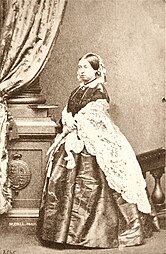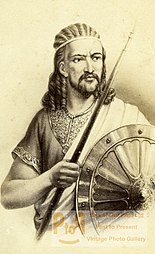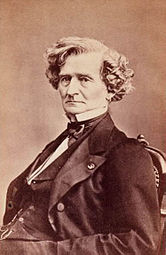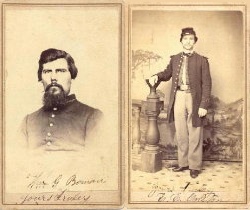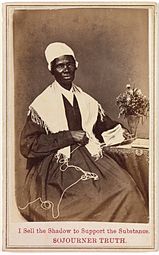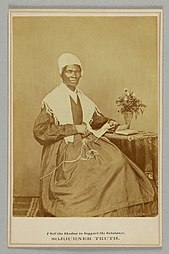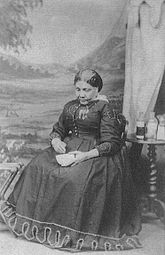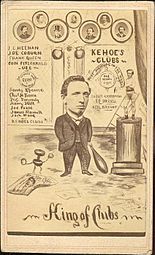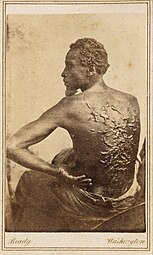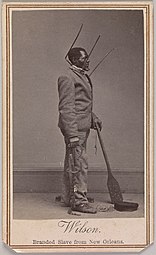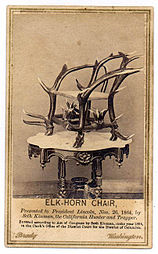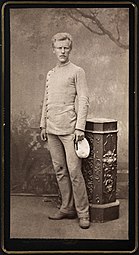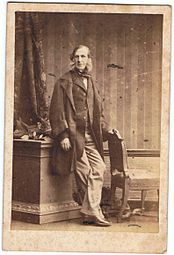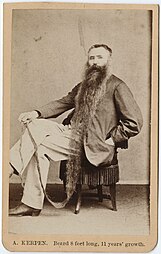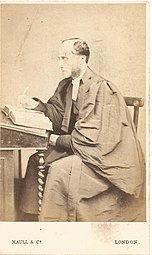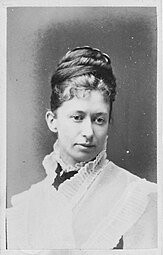Carte de visite: Difference between revisions
Jamesmcardle (talk | contribs) 1888 Kodak |
Jamesmcardle (talk | contribs) →Demise: ref |
||
| Line 21: | Line 21: | ||
== Demise == |
== Demise == |
||
By the early 1870s, ''cartes de visite'' began to be supplanted by "[[cabinet card]]s", which were also usually albumen prints, but larger, mounted on cardboard backs measuring {{convert|4.5|in|mm|order=flip|abbr=on}} by {{convert|6.5|in|mm|order=flip|abbr=on}}. Nevertheless, while larger framed prints became available at photography studios, the two smaller formats were the main trade of professional portrait photographers until 1888 when [[George Eastman]] introduced the mass produced [[Kodak#The Kodak camera|Kodak]] which industrialised the processing and printing of amateurs' photographs, and in 1900, the [[Brownie camera]], simplifying the technology and reducing the cost of the medium so that [[Snapshot (photography)|snapshot]] photography became a mass phenomenon.{{clear}} |
By the early 1870s, ''cartes de visite'' began to be supplanted by "[[cabinet card]]s", which were also usually albumen prints, but larger, mounted on cardboard backs measuring {{convert|4.5|in|mm|order=flip|abbr=on}} by {{convert|6.5|in|mm|order=flip|abbr=on}}. Nevertheless, while larger framed prints became available at photography studios, the two smaller formats were the main trade of professional portrait photographers until 1888 when [[George Eastman]] introduced the mass produced and pre-loaded [[Kodak#The Kodak camera|Kodak]] which industrialised the processing and printing of amateurs' photographs,<ref>{{Cite book |last=Riches |first=Harriet |title=Photography, history, difference |publisher=Dartmouth College Press, |year=2015 |isbn=9781611686463 |editor-last=Sheehan |editor-first=Tanya |series=Interfaces, studies in visual culture |location=Hanover, New Hampshire |pages=131 |language=en |chapter=Picture Taking and Picture Making: Gender Difference and the Historiography of Photography |oclc=880122479}}</ref> and in 1900, the [[Brownie camera]], simplifying the technology and reducing the cost of the medium so that [[Snapshot (photography)|snapshot]] photography became a mass phenomenon.{{clear}} |
||
== Gallery of ''cartes de visite'' == |
== Gallery of ''cartes de visite'' == |
||
Revision as of 05:44, 13 May 2023


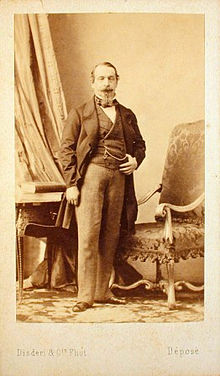
The carte de visite[1] (French: [kaʁt də vizit], visiting card), abbreviated CdV, was a format of small photograph which was patented in Paris by photographer André Adolphe Eugène Disdéri in 1854, although first used by Louis Dodero.[2][3] Each photograph was the size of a visiting card, and such photograph cards were commonly traded among friends and visitors in the 1860s. Albums for the collection and display of cards became a common fixture in Victorian parlors. The immense popularity of these card photographs led to the publication and collection of photographs of prominent persons.
History
Format
The carte de visite was usually an albumen print on thin paper glued onto a thicker paper card. The size of a carte de visite is 54.0 mm (2.125 in) × 89 mm (3.5 in) mounted on a card sized 64 mm (2.5 in) × 100 mm (4 in).
Camera

Special cameras were designed for their production In 1854, Disdéri had also patented a method of taking eight separate negatives on a single plate, which reduced production costs; rather than one large collodion plate being used to produce one image of the posed subject, Disdéri’s design initially exposed ten images on one plate, exposed either simultaneously or in sequence.
Each individual carte print was made at a fraction of the cost of producing one full-plate picture and ten were printed at once, saving time and thus efficiently serving the burgeoning consumer market for photography. Disderi’s patent was modified when eight images was found to be more practical, and in March 1860 optician Hyacinthe Hermagis patented a four-lens camera that became the standard.[4] Désiré Monckhoven reported in 1859;
We saw at M. Hermagis' a magnificent device, consisting of 4 identical double lenses mounted on a double frame camera built by M. Besson. This device, in a single operation, provides a plate on which 8 copies of the same image appear with perfect clarity. It seems that in the big cities, such as Paris, London, Berlin, St. Petersburg, these cartes de visite are widely used, so the device we saw at M. Hermagis' enjoys considerable success.[5]
Popularity
The carte de visite was slow to gain widespread use until 1859, when Disdéri published Emperor Napoleon III's photos in this format.[6] This made the format an overnight success. The new invention was so popular that its usage became known as "cardomania"[7] and spread quickly throughout Europe and then to America and the rest of the world.

The carte de visite photograph proved to be popular in America in the era of the Civil War; soldiers, friends and family members would have a means of inexpensively obtaining photographs and sending them to loved ones in small envelopes. Photos of Abraham Lincoln, Ulysses S. Grant, and other celebrities of the era became instant hits in the North. People were not only buying photographs of themselves, but also collecting photographs of celebrities.[8]
Demise
By the early 1870s, cartes de visite began to be supplanted by "cabinet cards", which were also usually albumen prints, but larger, mounted on cardboard backs measuring 110 mm (4.5 in) by 170 mm (6.5 in). Nevertheless, while larger framed prints became available at photography studios, the two smaller formats were the main trade of professional portrait photographers until 1888 when George Eastman introduced the mass produced and pre-loaded Kodak which industrialised the processing and printing of amateurs' photographs,[9] and in 1900, the Brownie camera, simplifying the technology and reducing the cost of the medium so that snapshot photography became a mass phenomenon.
Gallery of cartes de visite
-
One of the first cartes de visite of Queen Victoria taken by photographer John Jabez Edwin Mayall
-
Tewodros II of Ethiopia in the 1860s.
-
Hector Berlioz, c.1864
-
Two photographs taken during the American Civil War. Each soldier shown here served with the 77th Illinois Volunteer Infantry.
-
A later cabinet card of a similar image of Sojourner Truth.
-
One of only two known photographs of Mary Seacole, taken by Maull & Company in London, c.1873.
-
Sim D. Kehoe, who brought Indian-club exercising to the United States from England.
-
Gordon, an enslaved man, reproduced by Mathew Brady.
-
Wilson Chinn, a branded slave from Louisiana--Also exhibiting instruments of torture used to punish slaves
-
A chair presented by Kinman to Abraham Lincoln. Kinman sold CdVs in the U.S. Capitol.
-
Fridtjof Nansen, Arctic explorer and scientist 1886.
-
An early cat macro by British portrait photographer Harry Pointer, c.1870s.
-
Camille Silvy's portrait of William Fane De Salis, London, 1861.
-
A. Kerpen. Beard 8 feet long, 11 years' growth
-
Rev. Christopher Newman Hall, British clergyman c.1860
-
Elizabeth Thompson, military painter c.1875
See also
References
- ^ Also spelled carte-de-visite or erroneously referred to as carte de ville.
- ^ Welling
- ^ Leggat
- ^ Plunkett, John (2013-12-16). "Carte-de-visite". In Hannavy, John (ed.). Encyclopedia of Nineteenth-Century Photography. Routledge. pp. 276–277. ISBN 978-0-203-94178-2.
- ^ van Monckhoven, Desirée (1859). Répertoire général de photographie pratique et théorique contenant les procédés sur plaque, sur papier, sur collodion sec et humide, sur albumine etc (in French) (3rd, avec atlas composé de dix planches ed.). Paris: A. Gaudin et frère. p. 596. OCLC 476794826.
- ^ Gernsheim p. 55
- ^ Newhall
- ^ Schweitzer, Marlis, and Joanne Zerdy. 2014. Performing Objects and Theatrical Things. Houndmills, Basingstoke; New York : Palgrave Macmillan. ISBN 9781137402448.
- ^ Riches, Harriet (2015). "Picture Taking and Picture Making: Gender Difference and the Historiography of Photography". In Sheehan, Tanya (ed.). Photography, history, difference. Interfaces, studies in visual culture. Hanover, New Hampshire: Dartmouth College Press,. p. 131. ISBN 9781611686463. OCLC 880122479.
{{cite book}}: CS1 maint: extra punctuation (link)
Bibliography
- Gernsheim, Helmut (1986). A Concise History of Photography. Courier Dover Publications. ISBN 978-0-486-25128-8. Retrieved 2010-10-16.
- Dr. Robert Leggat MA M.Ed Ph.D. FRPS FRSA
- Newhall, Beaumont. The history of photograph (1964)
- Silkenat, David (August 8, 2014). ""A Typical Negro": Gordon, Peter, Vincent Coyler, and the Story Behind Slavery's Most Famous Photograph" (PDF). American Nineteenth Century History. 15 (2): 169–186. doi:10.1080/14664658.2014.939807. hdl:20.500.11820/7a95a81e-909c-4e8f-ace6-82a4098c304a. S2CID 143820019.
- Welling, William. Photography in America (1978 & 1987)
External links
- Portraits of Scientists: Increase Lapham's Cartes-de-visite Collection Collected by pioneering Wisconsin antiquarian Increase A. Lapham between 1862–75, this album of carte-de-visite photographic portraits depicts many notable 19th-century scientists from America and Europe. Available on Wisconsin Historical Images, the Wisconsin Historical Society's online image database.
- University of Washington Libraries Digital Collections – 19th Century Actors Photographs Cartes-de-visite studio portraits of entertainers, actors, singers, comedians and theater managers who were involved with or performed on the American stage in the mid-to-late 19th century.
- William Emerson Strong Photograph Album -- Duke University Libraries Digital Collections 200 cartes de visite depicting officers in the Confederate Army and Navy, officials in the Confederate government, famous Confederate wives, and other notable figures of the Confederacy. Also included are 64 photographs attributed to Mathew Brady.
- Southern Cartes de Visite Collection, A.S. Williams III American Collection, Division of Special Collections, University of Alabama Libraries. Over 3300 digitized cartes de visite, the majority of them from southern studios.
- The Carte de Visite file at the New-York Historical Society
- Cartes de Visite of California photographers at Beinecke Library via flickr
